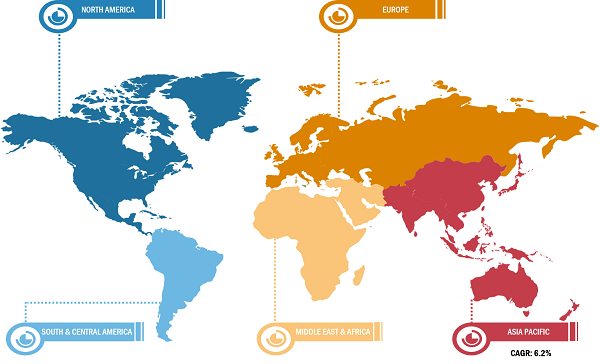Rising Demand for Hygiene and Incontinence Products Drives Market Growth
According to the latest market study on “Super Absorbent Polymer Market Forecast to 2030 – COVID-19 Impact and Global Analysis – by Type, Category, and Application,” the global super absorbent polymer market size was valued at US$ 7,336.14 million in 2022 and is projected to reach US$ 11,456.64 million by 2030; it is anticipated to record a CAGR of 5.7% from 2022 to 2030. The report highlights key factors driving the market growth and prominent players along with their developments in the market.
Super absorbent polymers are also used in the production of sanitary napkins due to their absorbent properties. The consumer expectations for hygiene and comfort rise continuously, thereby encouraging manufacturers to prioritize the utilization of advanced materials such as super absorbent polymers. Further, improved accessibility to sanitary napkins driven by both governmental and non-governmental efforts has made these products readily available to a large population.
Global Super Absorbent Polymer Market Breakdown – by Region
Super Absorbent Polymer Market Size and Forecast (2020 - 2030), Global and Regional Share, Trend, and Growth Opportunity Analysis Report Coverage: By Type (Polyacrylic acid (PAA), Polyacrylamide (PAM), Sodium Polyacrylate, Potassium Polyacrylate, Polysaccharides, and Others), Category (Synthetic, and Biobased), and Application (Personal Care, Agriculture, Healthcare, Building and Construction, and Others)
Super Absorbent Polymer Market 2030 | Size, Share, Growth, Scope
Download Free Sample
The rising demand for super absorbent polymers in the personal care industry, owing to their exceptional water-absorbing capacity, favors the market. These polymers are commonly used in products such as diapers, sanitary napkins, and adult incontinence products. Their ability to absorb and retain large amounts of liquid enhances the performance of these products, providing improved comfort and efficiency. The demand for super absorbent polymer rises as consumer preferences incline toward advanced and comfortable personal care products. The growing aging population directly translates to a more extensive customer base for adult diapers. Incontinence can significantly impact an individual's sense of dignity and independence.
Adult diapers enable individuals to engage in social interactions, travel, and participate in various activities without fear of accidents or leakage. According to the World Health Organization, 1 in 6 people in the world will be 60 years and above, by 2030. The share of the population aged 60 years and above is projected to grow from 1 billion in 2020 to 1.4 billion by 2030. The number of people aged 80 years and above is expected to triple between 2020 and 2050 to reach 426 million. The rising utilization of adult incontinence prompted several key companies to launch adult diapers. For instance, in 2022, Ascent Meditech expanded its personal protection portfolio by introducing adult diapers in the Indian market. Therefore, high demand for hygiene and incontinence products such as diapers and sanitary products positively influences the super absorbent polymer market.
Sanyo Chemical Industries Ltd, LG Chem Ltd, BASF SE, Sumitomo Seika Chemicals Co Ltd, Nippon Shokubai Co Ltd, Evonik Industries AG, Chase Corp, Yixing Danson Science and Technology Co Ltd, Songwon Industrial Co. Ltd, and Satellite Chemical Co Ltd. are among the key players in the global super absorbent polymer market.
Impact of COVID-19 Pandemic on Global Super Absorbent Polymer Market Growth
During the COVID-19 pandemic, disruptions in manufacturing operations severely impacted global supply chains and hindered super absorbent polymer operations, product delivery schedules, and sales. Various chemicals and materials companies reported product delivery delays and sales slump in 2020. Moreover, restrictions on international travel imposed by governments of various North American and Asia Pacific countries compelled manufacturers and suppliers to temporarily discontinue their business strategies, such as partnerships as well as research and development. All these factors hampered many sectors during the pandemic and restrained the growth of the chemicals & materials industry. During the pandemic, supply chain disruptions, raw material and labor shortages, and operational difficulties created demand and supply gaps, adversely affecting the growth of the super absorbent polymer market.
In 2020, supply chain shortages, increased labor costs, and high demand for raw materials resulted in price inflation of materials required in personal care across various regions. In 2021, rising vaccination rates contributed to improvements in the overall conditions in different countries, which led to a conducive environment for healthcare, agriculture, and construction. By the end of 2021, the sales of super absorbent polymers increased with the resumption of services of the end-use industries.
The "Global Super Absorbent Polymer Market Analysis and Forecast to 2030" is a specialized and in-depth study of the chemicals & materials industry, focusing on the global super absorbent polymer market trend analysis. The report aims to provide an overview of the market with detailed market segmentation. The global super absorbent polymer market is divided on the basis of type, category, and application. Based on type, the market is segmented into polyacrylic acid (PAA), polyacrylamide (PAM), sodium polyacrylate, potassium polyacrylate, polysaccharides, and others. Based on category, the market is divided into synthetic and biobased. In terms of application, the market is segmented into personal care, agriculture, healthcare, building and construction, and others.
PAA is a high-molecular-weight polymer prepared from acrylic acid. PAA is an anionic polymer, i.e. side chains are ionized at neutral pH, carrying a negative charge. PAM is a high molecular weight, water-soluble synthetic linear polymer manufactured from acrylamide or the combination of acrylamide and acrylic acid. Sodium polyacrylate is a cross-linked polymer containing sodium atoms. It absorbs water by a process called osmosis. It has high absorbing capability as compared to other polymers. Potassium polyacrylate is a potassium-based super absorbent polymer and is the economical and best water-absorbent material. It is nontoxic, harmless, nonpolluting and is highly consumed in the agriculture industry. Polysaccharides are highly available biopolymers with a variation of structure and properties. They are nontoxic, biocompatible, and biodegradable and are potential substitutes for synthetic polymers.
Contact Us
Phone: +1-646-491-9876
Email Id: sales@theinsightpartners.com